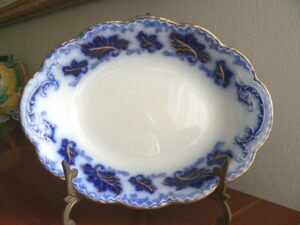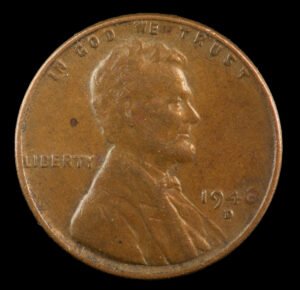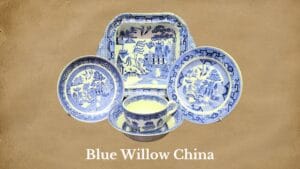Does identifying and valuing old Roseville pieces exhaust you? I totally understand. But what if your Roseville pottery piece is as valuable as the Della Robbia Vase sold for over $38,000, that too, in the 90s?
That’s why identifying and appraising an old Roseville piece correctly is crucial. But, I often find collectors frazzled by varying Roseville marks, signs, and patterns, confusing timeless Roseville pieces for ordinary ones.
So, today I’m here with a guide that will make Roseville pottery identification and valuation a cakewalk for you. From hand-drawn Roseville marks to patterns and values, you’ll find everything below.
Key Takeaways
- Common Roseville Pottery pieces can be valued at $50 – $300, but some popular designs or rare sizes can fetch premium prices from $500 – $2,000 or more.
- Della Robbia, Pinecone, Egypto, and Futura are some of Roseville Pottery’s most sought-after and valuable designs.
- The most expensive single Roseville piece is a Della Robbia 20’’ Vase that won the auction at $38,850!
- You can spot the fake Roseville pieces by their unusual logos and different shapes, colors, or sizes than the original pieces.
Brief History of Roseville Pottery Company
Roseville USA Pottery is a vintage stoneware pottery made by the Roseville Pottery Company from the 1890s to 1953-54. This company was founded in Roseville, Ohio, in 1890 by J.F. Weaver, who later joined hands with a Roseville salesman, George Young.
From 1892 to 1898, the company made countless household stoneware items and also acquired Midland Pottery and Clark Stoneware Company. In the early 1900s, it welcomed pottery designer Ross C. Purdy, who designed Roseville’s first art line, “Rozane!”
From 1904 to 1953, the company manufactured many popular pottery designs under the art director Frederick Hurten Rhead and then Frank Ferrell. Soon, it became one of the biggest manufacturers of American art pottery.
But, in 1954, Roseville Pottery Company sold its assets to Mosaic Tile Company due to bankruptcy and was officially shut. In 2017, The Kings Fortune acquired the Roseville Pottery patents and made limited edition Art Noveau tiles.
Finding the Value of Roseville Pottery With 4 Easy Steps
Roseville Pottery is one of the most popular American art pottery pieces ever. And today, after seventy years, it’s still popular but now as valuable vintage pottery.
The value of common vintage Roseville pottery can range from $50 to $500 in excellent condition, while some rare designs, such as the Della Robbia, Futura, Water Lily, etc., can be worth up to $800 – $2,500 or more.
Obviously, the price jump is high. That’s because many factors, such as its condition, size, rarity, and artistry, determine the final Roseville pottery value. Learn how to appraise a Roseville pottery piece in 4 steps considering crucial factors:
1. Evaluate the Condition & Quality
The condition of a Roseville pottery piece can make or break the deal. While mild crazing is bearable for collectors, more damage than that can devalue a Roseville piece by up to 50%, especially for valuable lines like the Rozane!
This means a poor-quality, cracked, or chipped Roseville will be worth less. But, if the design is popular and rare, collectors may still pay a decent but relatively lesser price.
But remember, “too perfect condition” can also be an alert! That’s because sellers tend to get old handmade pieces restored if they’re damaged. This may include repainting, filling the cracks, polishing, and reglazing.
Such restored Roseville pieces lose their original crafting touch and are depreciated, fetching 50% to 80% of the original piece.
2. Check the Rarity & Desirability of Roseville Patterns
This correlation is simple: the rarer a Roseville pattern, the more desirable and valuable the pottery.
Roseville’s Della Robbia, Rozane, Futura, Egypto, Pinecone, and Velmoss are among the most valuable patterns, worth up to thousands of dollars. Other designs like Apple Blossom, White Rose, Zephyr Lily, and Blackberry are popular, too, but are less valuable.
In fact, the Della Robbia is the rarest and most valuable Roseville pottery to date. In 1999, an unusual Roseville Della Robbia 20’’ Vase was auctioned for $38,850! And even today, this Della Robbia Roseville pattern can easily sell for up to $1,000 – $2,000!
Apart from these, here are the nine most popular Roseville Patterns and their values based on recent auctions and sales:
- 1. Rozane (1900): Rozane is Roseville’s earliest line of early hand-painted ceramic pottery. This line has several patterns, such as Rozane Mongol, Royale, Olympic, Mara, & Egypto! Based on these patterns, Rozane Pottery can be valued at around $100 – $1,000!
- 2. Della Robbia (1905): This Roseville pattern is about hand-painted or hand-carved glazed designs inspired by ancient Italian Della Robbia art featuring mostly a pale green base. It’s the most desired pattern and worth around $1,000 or more; a rare vase with rare Della Robbia pattern with dragons sold for $8,295 on eBay!
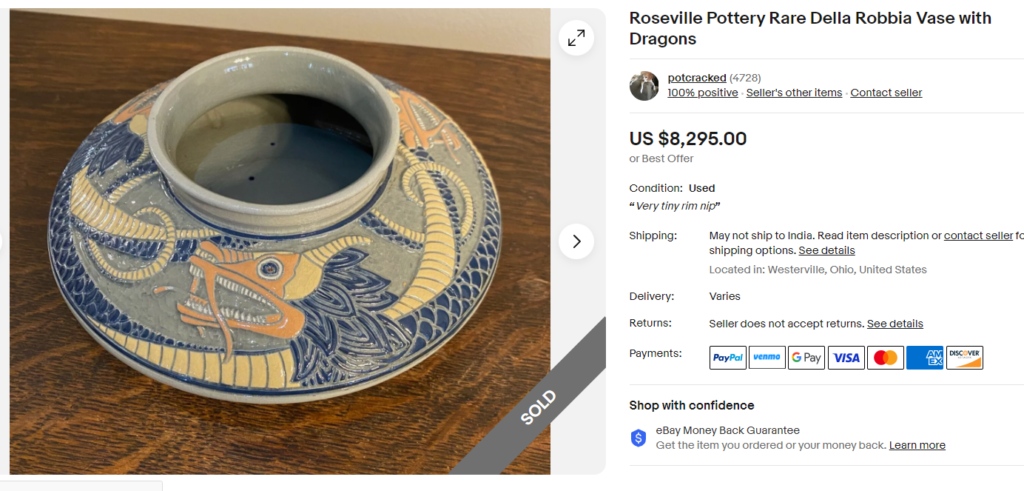
- 3. Egypto (1905): As the name suggests, this pattern has Egyptian shapes and motifs in its iconic matt green shade. Egypto pottery ranges from $400 to $1,000, even more for rare shapes & sizes, like a 16’’ tall Roseville Egypto Vase that fetched $2,900!
- 4. Donatello (1916): This pattern is known for its brownish-tan semi-matte base with embossed cherubic figures between light green ribbed borders. Large Roseville Donatello vases and jardinieres are worth around $300 – $500, while small flower pots, bowls, mugs, etc., fall under $100!
- 5. Futura (1928): This Roseville pattern stands out with its Art Deco-inspired designs, like innovative geometric shapes and bold colors. Large Roseville vases like Futura Balloon Globe Vases can be worth $1,000 – $1,600 or more.
In fact, even medium geometrical Futura vases, bowls, & wall pockets can sell for $400 – $1,000. Smaller Futura pottery can be valued below $200!
- 6. Pinecone (1931): This pattern shows detailed pinecone and pine needle motifs in rich blue, light green, and golden brown shades. Large Pinecone jards and umbrella stands, like this 14’’ tall Pincone Pottery, can be worth up to $1,500.
On the other hand, Pinecone vases and pitchers are valued at around $100 – $600. Smaller Pinecone pottery, like mugs, ashtrays, bowls, etc., cost even under $200.
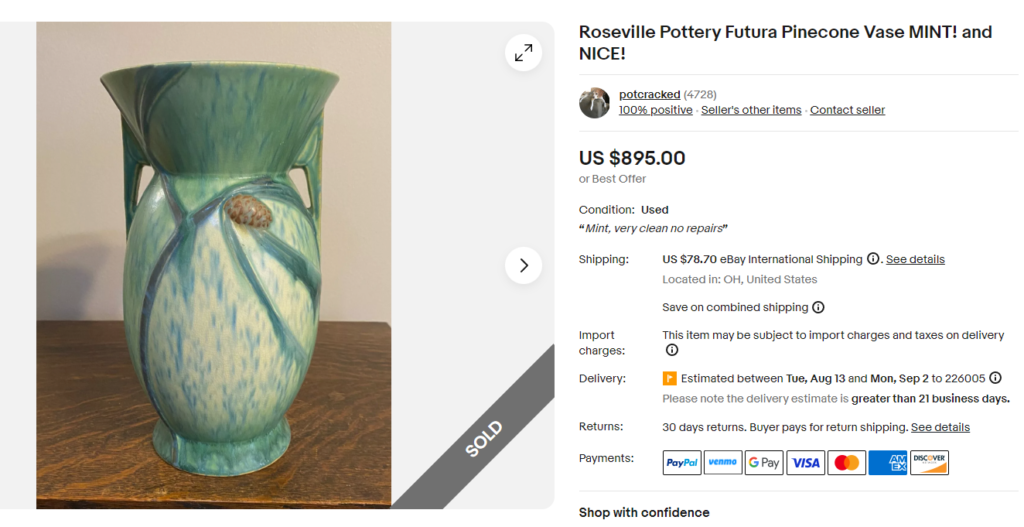
- 7. Blackberry (1932): Blackberry is a nature-inspired middle-period design featuring raised blackberry motifs in dark purple with a green or brown base and green leaves. Usually, Roseville Blackberry Pottery sells for $100 – $600.
- 8. Apple Blossom (1948): This mid-century modern pattern displays white and pastel pink apple blossoms with green leaves and light brown branches and is worth around $90 – $300. Remember that the price also fluctuates according to the colors: green, blue, and pink.
For example, green Roseville Apple Blossom mid-century Modern jardinieres can sell for around $200. But blue or pink Apple Blossom pottery generally cost $50 – $170.
- 9. White Rose (1940): As the name says, white rose pottery features gorgeous white flowers and green leaves on brown, pink, and light blue glaze pottery. The value of large White Rose pottery pieces can go up to $1,000, while smaller and common pieces are around $50 – $200.
3. Identify the Pottery Type & Items

The company made plenty of household items and stoneware. So, the value of the old Roseville Pottery also depends on what item it is.
Large-size (10’’-14”) Roseville vases, jardinieres, and umbrella stands can range from $500 – $2,000. Bowls, pitchers, and wall pockets are worth around $100 – $500, with higher values of up to $1000 for rare pieces.
For instance, a rare Roseville Pinecone Centerpiece Bowl won a steep price tag of $2,000 on eBay, despite being just a regular-size pottery.
Likewise, Roseville bookends usually sell in the $50 – $200 range, while ashtrays don’t fetch over $100 generally, even in mint condition, unless a rare pattern.
4. Check the Pottery Size
Yes, size can also impact the value of old Roseville pottery, but you must also consider factors, like rarity and condition, too! In short, bigger pottery doesn’t always mean valuable pottery.
For instance, a cracked, big Roseville pottery vase with a less popular design may fetch lesser returns than a small, unusual Roseville paperweight or inkwell.
Identifying Important Roseville Pottery Marks and Signs

When it comes to valuable antique ceramics, the market has many collectible brands. So understanding the following features will help you identify Roseville pottery easily.
1. Roseville Pottery Company Marks & Logos
The best way to spot Roseville Pottery is by checking the brand logo or any embossed or impressed mark at the bottom. While many pieces have the clear “Roseville,” “Rozane Ware,” or “Roseville Pottery” marks, some may not, but they’re still Roseville.
Confused? Don’t worry! The following Roseville Pottery Age Chart with hand-drawn brand marks will help you identify and date your piece rightly:
| Manufacturing Year | Roseville Pottery Logos (Bottom) | Estimated Age |
| 1896-1900 | Impressed shape no. in cursive digits | 120-125+ years |
| 1905-1908 |  | 115-118 years |
| 1910-1928 |  | 95-110+ years |
| 1914-1933 |  | 90-109 years |
| 1915 |  | 108 years |
| 1925-1935 |  | 88-98 years |
| 1927-1935 |  | 88-95 years |
| 1936-1938 |  | Around 85 years |
| 1939 -1954 |  | 70-85 years |
Apart from these, I’ve also seen a few Roseville Pottery pieces with “TRIAL” marks along with shape numbers and color numbers from the 1930s and 1940s. These marks are typical crayon marks drawn under the bottom glaze.
Such old Roseville trial pieces with these marks are extremely rare, worth thousands, like this Roseville Trial RARE Futura TRIAL Glaze AZTEC Ladies 1072-4 Candle Holders sold for around $1,573!
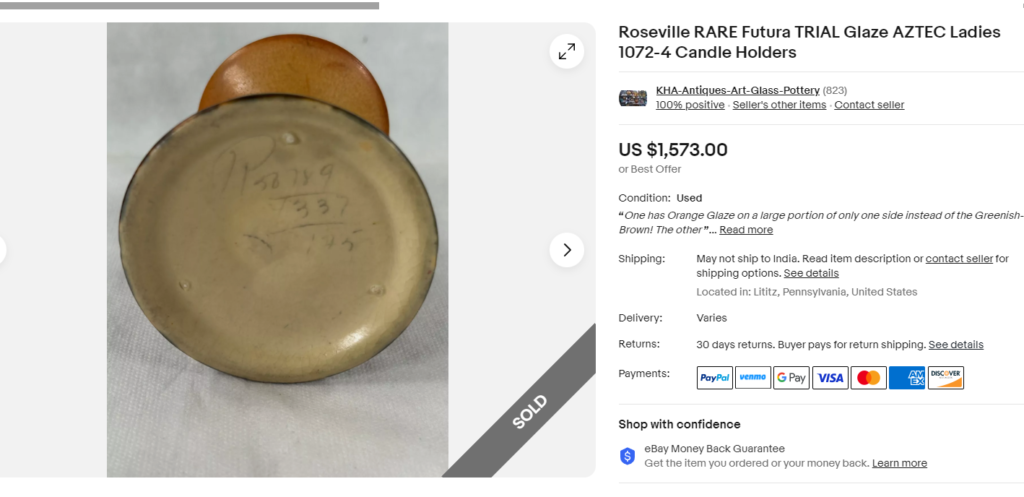
Check out my Roseville Pottery Company Marks Guide for more comprehensive information!
2. Size & Shape Numbers
As you noticed above, there are some numbers on Roseville pieces’ bottoms, which signify the size and shape of the piece.
Usually, the earliest pieces from 1890 to the early 1900s have the impressed molded shape number marks on the bottom. Similarly, the 1925-35 Roseville pottery can only have the crayon shape number marks.
But, the mid-1930s and later pieces bear the Roseville logo, along with the shape and size numbers, in the following formats:
- “Roseville/XYZ-AB”
- “Roseville/U.S.A./XYZ-AB”
- “Roseville/U.S.A/XYZ-AB/Design name (e.g. Roseville/U.S.A./954.7/Mock Orange)
Here, the middle, three-digit number (XYZ) indicates the shape (vases, bowls, plates, jardinieres, etc.), and the one or two-digit number (AB) indicates the size.
3. Artist or Maker Signatures
If a Roseville piece bears its artist or designer’s signature or marks, it becomes more precious for collectors.
Ross C. Purdy, who designed the Roseville Rozane Line in 1900, is one of its earliest designers. But Roseville pottery with Purdy’s sign is very hard to find.
Below are some more popular Roseville designers and their signs that can hike the price of Roseville:
| Artist Names | Signatures | Roseville Designs |
| Frederick Hurten Rhead (aka Frederick Rhead) |  | Della Robbia, Olympia |
| Harry Rhead |  | Donatello, Carnelian, Pauleo |
| Frank Ferrell |   | Pinecone |
| John Harold | 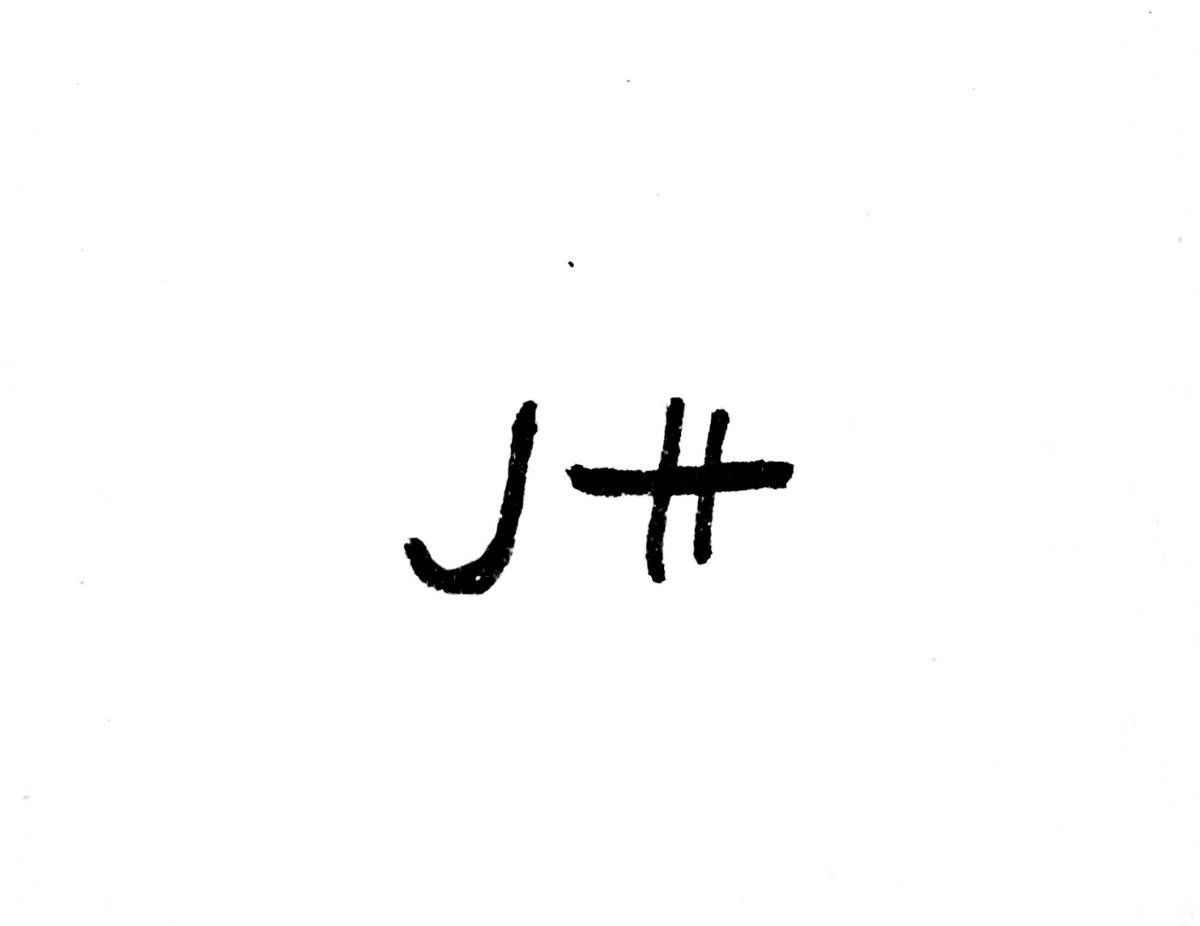 | Mara, Mongol (Rozana) |
In addition to the above artists, many other designers worked on different Roseville pottery lines and patterns. You can learn all about the Roseville pottery artists and their signs here!
Reproduced or Fake Roseville Pottery – How to Spot Them?
Since Roseville is highly popular among antique collectors, it’s easy for makers to sell Roseville reproductions or fakes for hefty prices.
While you may think you can spot real Roseville by the marks, it’s not that easy. Many fake handmade pieces also have similar brand marks. So, how do you spot the FAKE Roseville Pottery?
Well, I’ve received many fake Roseville items to appraise in my career. And there are many signs that can reveal whether the pottery is fake or real.
I’ve prepared a checklist with all the features I’ve ever found on a Roseville reproduction or fakes. Just grab your piece and verify if the following features are there or not!
- A very dull glaze compared to a similar original piece
- Poor details in the patterns
- Thicker & heavier handles than the original pieces
- Different shapes & dimensions than the original shape of the same model
- Varying colors (shades) than the original model
- The floral pattern & leaves are dull
- Low relief “Roseville U.S.A.” logo on the bottom
- Only mold-raised “Roseville” logo on the base
If you marked any of these boxes, then you likely have fake or reproduced Roseville Pottery, which is not valuable at all. So beware!
Roseville pottery is the most valued vintage pottery every collector wants on their shelves. This price guide is the best tool for finding the right price for any Roseville piece you want. If you need more helpful price guides on McCoy Pottery or Frankoma Pottery, join me now!
Note: This article is intended for informational, educational, and entertainment purposes only. Some images are illustrative and may not represent actual brands, products, or related entities. All trademarks, product names, brand logos, packaging, and other intellectual property referenced remain the exclusive property of their respective owners. Any brand mentions or references are provided solely for descriptive and educational context and do not imply any formal or commercial association.



